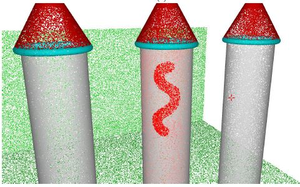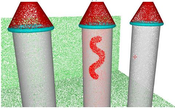Information
- Publication Type: Master Thesis
- Workgroup(s)/Project(s):
- Date: November 2017
- Date (Start): 10. October 2016
- Date (End): 17. October 2017
- Diploma Examination: 9. January 2018
- First Supervisor: Michael Wimmer
Abstract
This thesis presents a semi-automated method for shape detection in out-of-core point clouds. Rather than performing shape detection on the entire point cloud at once, a user-controlled interaction determines the region that is to be segmented next. By keeping the size of the region and the number of points small, the algorithm produces meaningful results within a fraction of a second. Thus, the user is presented immediately with feedback on the local geometry. As modern point clouds can contain billions of points and the memory capacity of consumer PCs is usually insufficient to hold all points in memory at the same time, a level-of-detail data structure is used to store the point cloud on the hard disc, and data is loaded into memory only on use. This data structure partitions the point cloud into small regions, each containing around 5000 points, that are used for rendering and shape detection. Interacting with point clouds is a particularly demanding task. A precise selection of a region of interest, using the two-dimensional lasso interaction, often needs multiple view changes and subsequent improvements. This thesis proposes improvements to the lasso interaction, by performing selection only on the set of points that are approximated by a detected shape. Thus, the selection of undesired points in the fore- and background is reduced. Point picking is improved as well by the use of a detected shape, such that only points that are approximated by this shape are pick-able. The result of this thesis is an application that allows the user to view point clouds with millions of points. It also provides a novel interaction technique for quick local shape detection as well as shape-assisted interactions that utilize this local semantic information to improve the user’s workflow.Additional Files and Images
Weblinks
No further information available.BibTeX
@mastersthesis{Rainer_2017,
title = "Interactive Shape Detection in Out-of-Core Point Clouds for
Assisted User Interactions",
author = "Bernhard Rainer",
year = "2017",
abstract = "This thesis presents a semi-automated method for shape
detection in out-of-core point clouds. Rather than
performing shape detection on the entire point cloud at
once, a user-controlled interaction determines the region
that is to be segmented next. By keeping the size of the
region and the number of points small, the algorithm
produces meaningful results within a fraction of a second.
Thus, the user is presented immediately with feedback on the
local geometry. As modern point clouds can contain billions
of points and the memory capacity of consumer PCs is usually
insufficient to hold all points in memory at the same time,
a level-of-detail data structure is used to store the point
cloud on the hard disc, and data is loaded into memory only
on use. This data structure partitions the point cloud into
small regions, each containing around 5000 points, that are
used for rendering and shape detection. Interacting with
point clouds is a particularly demanding task. A precise
selection of a region of interest, using the two-dimensional
lasso interaction, often needs multiple view changes and
subsequent improvements. This thesis proposes improvements
to the lasso interaction, by performing selection only on
the set of points that are approximated by a detected shape.
Thus, the selection of undesired points in the fore- and
background is reduced. Point picking is improved as well by
the use of a detected shape, such that only points that are
approximated by this shape are pick-able. The result of this
thesis is an application that allows the user to view point
clouds with millions of points. It also provides a novel
interaction technique for quick local shape detection as
well as shape-assisted interactions that utilize this local
semantic information to improve the user’s workflow.",
month = nov,
address = "Favoritenstrasse 9-11/E193-02, A-1040 Vienna, Austria",
school = "Institute of Computer Graphics and Algorithms, Vienna
University of Technology ",
URL = "https://www.cg.tuwien.ac.at/research/publications/2017/Rainer_2017/",
}

 image
image Master thesis
Master thesis


